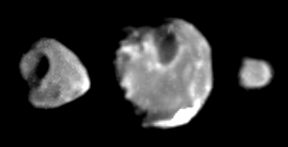Bombarded by charged particles and exposed to large magnetic fields, the Galileo spacecraft recently braved several passes through Jupiter’s radiation belts to get a closer look at the planet’s volcanically active moon Io. As it neared Io, the craft also captured portraits of Metis, Amalthea, and Thebe, three of Jupiter’s small, innermost moons.

The new images, released April 24, resolve features as small as 2 kilometers, half the size of the tiniest structures previously visible.
The pictures show that a bright feature on Amalthea, which had appeared to be round in older images taken at other viewing angles, is in fact a 50-km-long streak. Known as Ida, the streak could be material thrown upward when an impactor gouged a nearby crater, or it could mark the crest of a ridge, says Galileo researcher Damon Simonelli of Cornell University.
The craft found that a bright patch near Amalthea’s south pole, discovered in 1979, is the brightest spot on any of the three moons. The region sits astride a large crater and could be material melted into a glass, pulverized, or excavated by the asteroid or comet that struck there. That’s bright only in the relative sense, notes Simonelli, since each moon is quite dark.
On Thebe, Galileo found a 40-km-wide crater that scientists named Zethus, after Thebe’s husband in Greek mythology.







